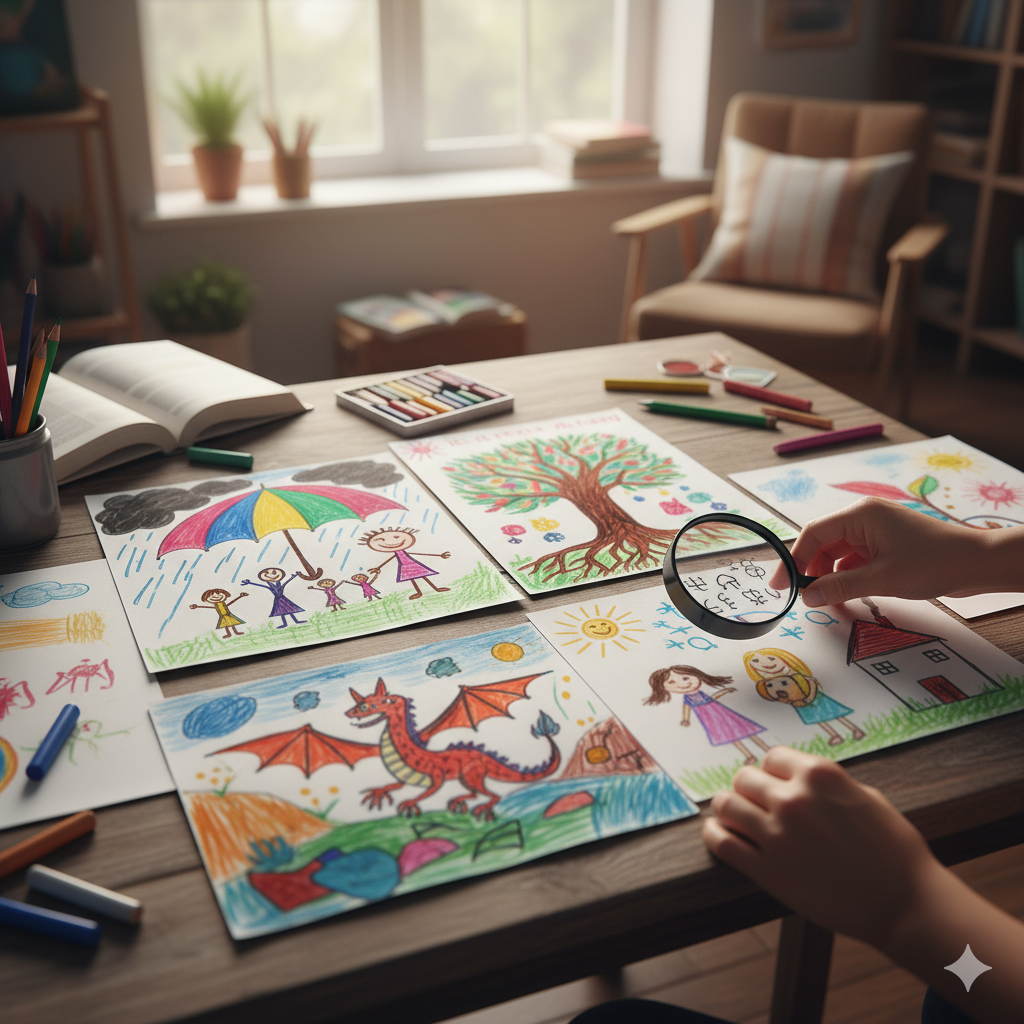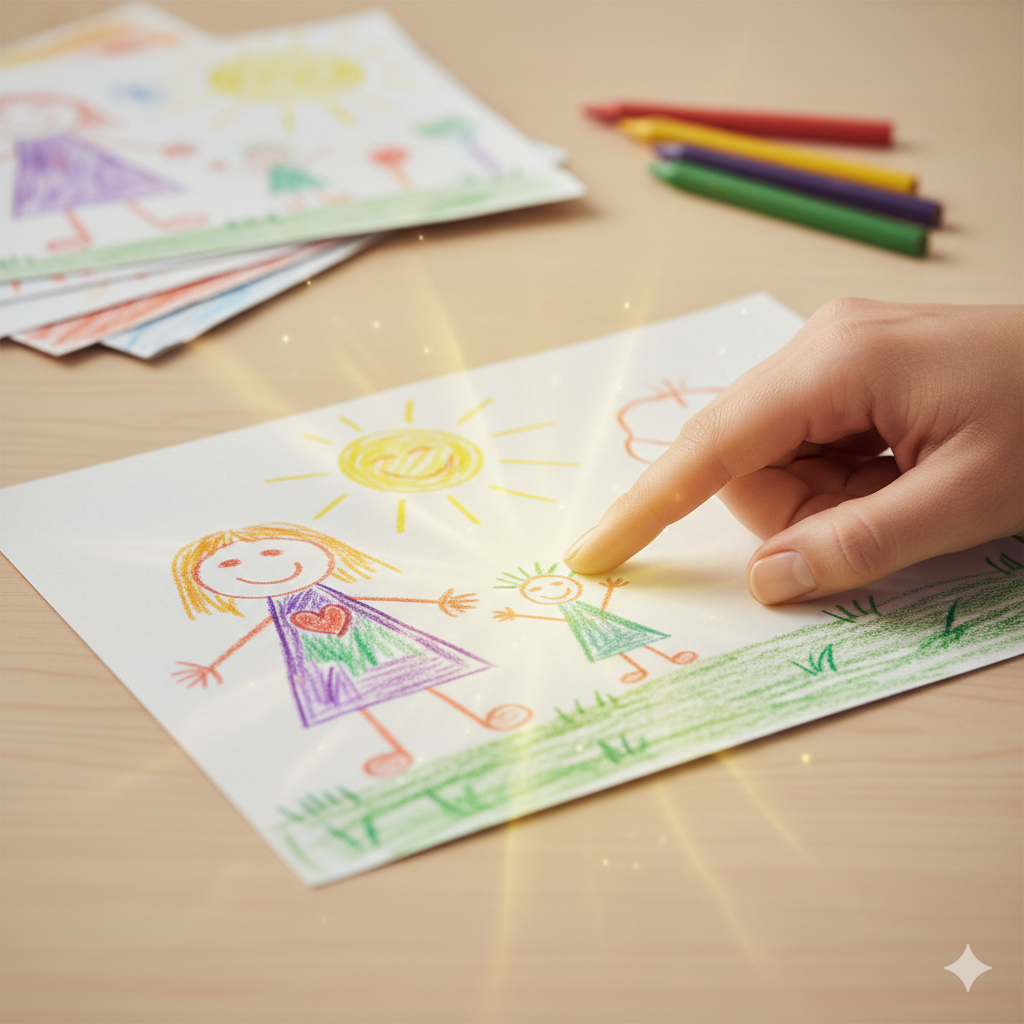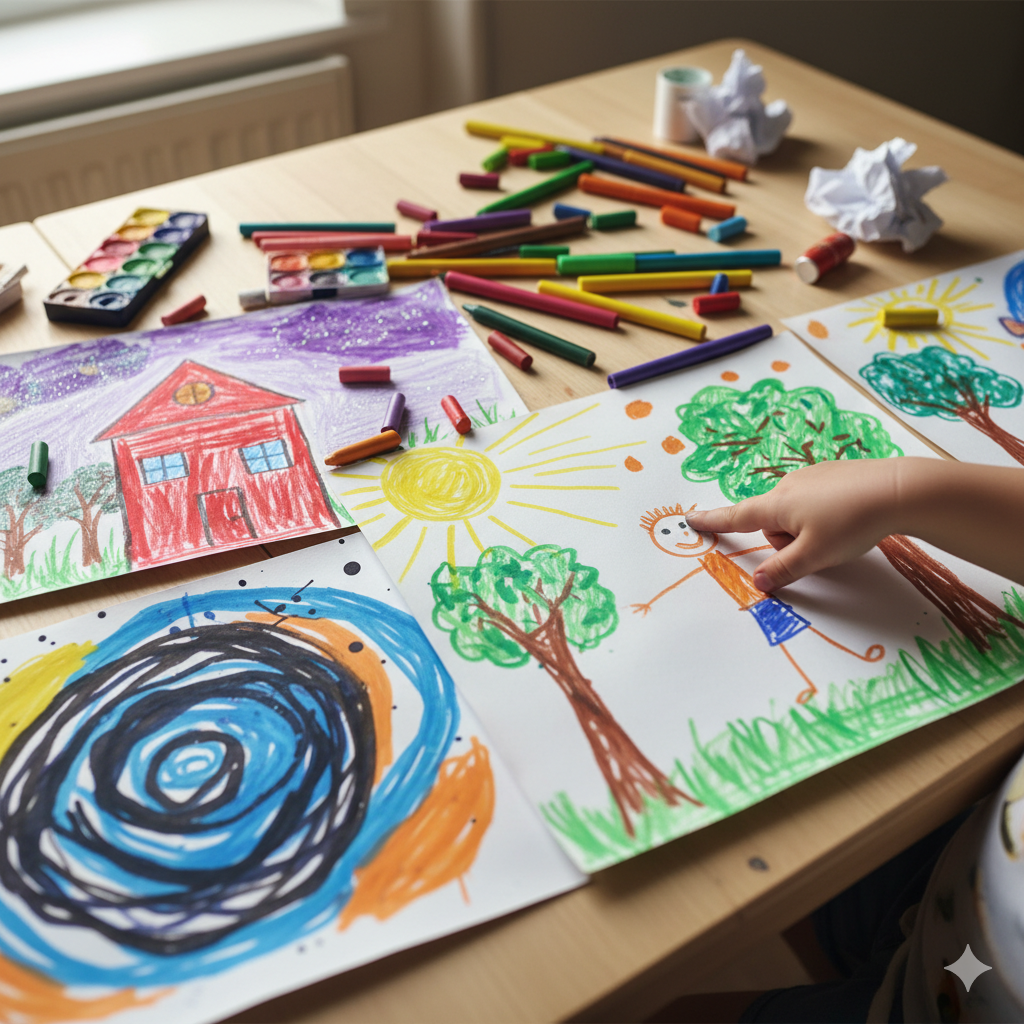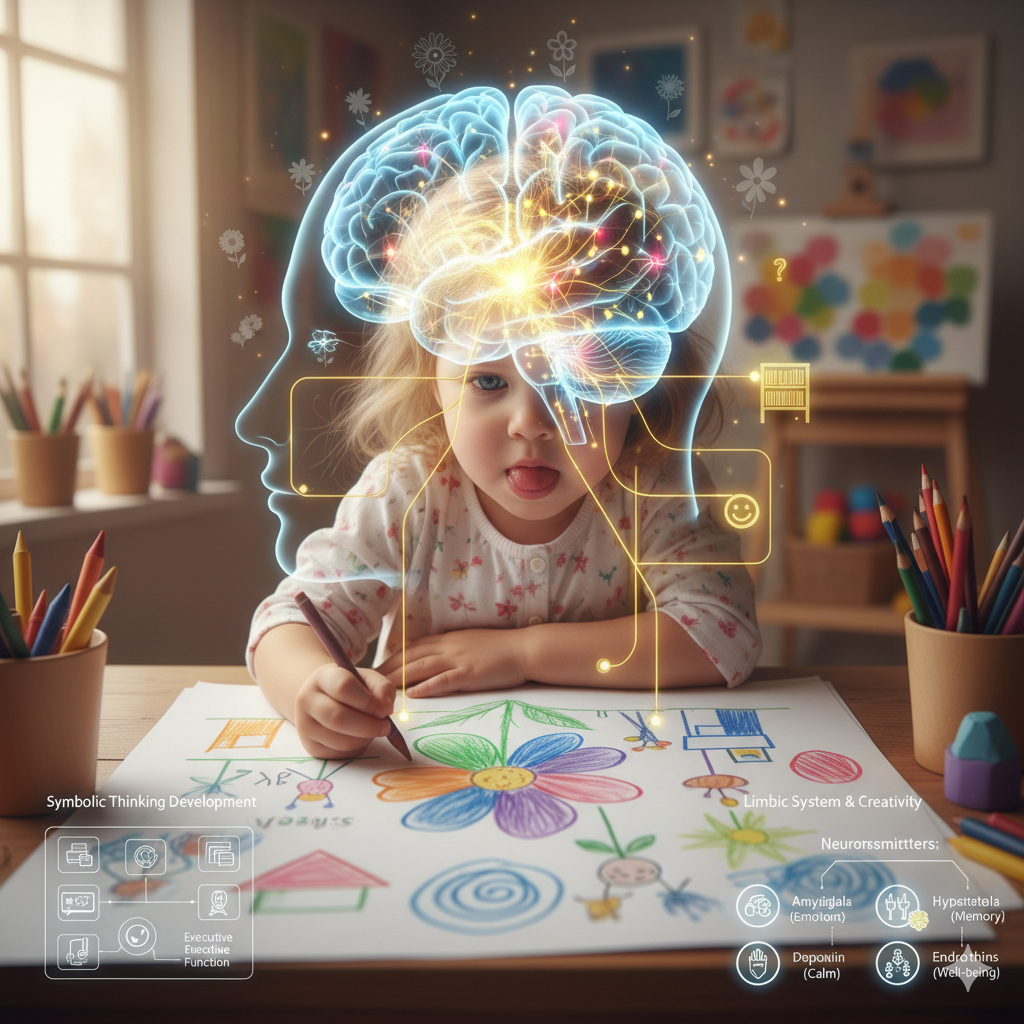Understanding Symbols and Patterns in Children's Artwork
I'll never forget the day my six-year-old daughter drew a picture of our family standing under a giant umbrella during a thunderstorm. At first glance, it seemed like a simple weather scene, but as I listened to her explain her drawing, I realized I was witnessing something profound. "The umbrella is keeping us safe from the scary storm," she said, pointing to the dark clouds above. "But we're all together, so we're okay." That moment taught me that children's artwork is far more than just pretty pictures—it's a rich tapestry of symbols and patterns that reveal their inner thoughts, feelings, and experiences.
Children's artwork is like a secret language, one that speaks through symbols, patterns, and visual metaphors. While we should never over-interpret or make definitive psychological assessments based on drawings alone, learning to recognize common symbols and patterns can provide valuable insights into your child's world. This guide will help you understand the symbolic language of children's art and recognize patterns that may indicate important aspects of their development and emotional life.
The Secret Language of Children's Art
What Makes Symbols So Powerful
When my daughter drew that umbrella protecting our family, she wasn't just creating a picture—she was using symbols to communicate something she couldn't put into words. Symbols in children's artwork are visual representations that stand for ideas, feelings, objects, or experiences. They're like a bridge between a child's inner world and their ability to express it.
Children naturally use symbols because their developing minds are constantly making connections between what they see, feel, and experience. As their cognitive development progresses, they begin to understand that one thing can represent another—a circle can be a face, a line can be a house, and colors can represent specific objects or feelings. It's like watching their brain learn a new language right before your eyes.
The Different Ways Children Use Symbols
I've noticed that my children use symbols in three distinct ways. Sometimes they're literally representing something—a circle is simply a face, a line is just a house. Other times, they're expressing something metaphorical—a storm might represent emotional turmoil, a bridge might represent connection or transition, or a tree might represent growth or family.
But the most fascinating symbols are the personal ones—the unique representations that have meaning only to them. My son has a particular way of drawing his favorite toy that has evolved over time, and it's become his personal symbol for comfort and security. These personal symbols often develop over time and carry deep meaning that only the child truly understands.
Common Symbols in Children's Artwork
Human Figures and Family
Self-Representation:
Self-representation can be analyzed through size where larger self-portraits may indicate confidence or self-importance, placement where central placement often shows self-focus, details where more detailed self-portraits may indicate self-awareness, and expression where facial expressions reveal emotional state.
Family Members:
Family member representation includes inclusion showing who's included and who's missing, size where larger figures may represent importance or authority, distance where physical distance may indicate emotional distance, and interaction showing how family members relate to each other.
Friends and Peers:
Friends and peers in artwork reveal group dynamics showing how the child positions themselves in groups, social relationships indicating who they draw with and how, peer influence through how friends are portrayed, and social confidence showing comfort level in social situations.
Nature and Environment
Trees:
Trees in children's artwork often represent growth and development showing the child's sense of growth, family structure with roots as family foundation and branches as family members, stability where strong, healthy trees may indicate security, and seasons where different seasons may represent different life phases.
Houses:
Houses typically represent security and safety as they often represent the child's sense of home, family life where windows and doors may represent openness or privacy, stability where well-drawn houses may indicate security, and dreams where elaborate houses may represent aspirations.
Sun and Sky:
The sun and sky in artwork often reflect mood and atmosphere where bright sun may indicate happiness, hope and optimism as sunny skies often represent positive outlook, weather where storms may represent emotional turmoil, and time where sun position may indicate time of day or life phase.
Water:
Water in children's drawings often represents emotions and feelings with emotional flow, life and growth as water is a source of life, change and transition as water symbolizes movement, and depth where deep water may represent complex emotions.
Animals and Creatures
Pets:
Pets in artwork often represent companionship as they often represent love and loyalty, comfort as pets are sources of emotional support, responsibility through caring for animals, and loss where missing pets may represent grief.
Wild Animals:
Wild animals may symbolize power and strength where large animals may represent inner strength, freedom as wild animals may represent desire for independence, fear where dangerous animals may represent anxieties, and protection where protective animals may represent security needs.
Fantasy Creatures:
Fantasy creatures like dragons, unicorns, and other creatures represent imagination, power through supernatural abilities and strengths, escape as fantasy provides a way to escape reality, and identity where fantasy creatures serve as extensions of self.
Objects and Tools
Vehicles:
Vehicles like cars, planes, and boats often represent movement and change, independence as vehicles are symbols of freedom, adventure through travel and exploration, and control by being in charge of movement.
Weapons:
Weapons including swords, guns, and other weapons may represent power and control, protection through defending against threats, aggression by expressing anger or frustration, and fantasy where weapons appear in imaginary scenarios.
Toys and Games:
Toys and games in artwork often represent play and fun through joy and entertainment, childhood by maintaining youth and innocence, competition where games serve as symbols of challenge, and social interaction through playing with others.
Recognizing Patterns in Children's Artwork
Recurring Themes
Family Themes:
Family themes in artwork include family portraits with frequent drawings of family members, family activities showing scenes of family together, family conflicts depicting arguments or tensions, and family celebrations showing holidays and special occasions.
School Themes:
School themes encompass classroom scenes showing school activities and learning, friends at school depicting social interactions with peers, teachers as authority figures and mentors, and school challenges showing academic or social difficulties.
Fantasy Themes:
Fantasy themes include superheroes representing power and protection fantasies, princesses and princes showing royalty and special status, monsters representing fears and anxieties, and magical worlds providing escape and imagination.
Color Patterns
Consistent Color Choices:
Consistent color choices include favorite colors showing personal preferences and associations, mood colors that reflect emotional states, seasonal colors associated with different times of year, and cultural colors with specific cultural meanings.
Color Combinations:
Color combinations involve complementary colors that work well together, monochromatic schemes with variations of a single color, warm vs. cool colors showing emotional temperature, and bright vs. muted colors indicating intensity of emotional expression.
Composition Patterns
Layout Preferences:
Layout preferences include centered compositions focusing on central elements, asymmetrical arrangements creating dynamic, interesting layouts, grid patterns showing organized, structured thinking, and flowing compositions with organic, natural arrangements.
Size Relationships:
Size relationships involve large central figures indicating importance and focus, small peripheral elements serving as supporting details, proportional relationships showing realistic vs. symbolic sizing, and scale variations using different sizes for different meanings.
Developmental Patterns in Symbol Use
Age-Related Symbol Development
Early Childhood (2-4 years):
Early childhood symbol use includes basic symbols with simple shapes representing objects, personal symbols that are unique representations, literal meaning where symbols are closely tied to real objects, and emerging metaphors as children begin to use symbols metaphorically.
Middle Childhood (5-8 years):
Middle childhood develops complex symbols with more sophisticated representations, cultural symbols learned from the environment, emotional symbols that express feelings, and narrative symbols that tell stories.
Late Childhood (9-12 years):
Late childhood features abstract symbols representing ideas and concepts, personal style with unique symbolic language, cultural awareness through understanding of cultural symbols, and symbolic thinking with advanced use of symbols.
Individual Differences
Personality Factors:
Personality factors influence symbol use as introverted children may use more personal symbols, extroverted children may use more social symbols, creative children may develop unique symbolic language, and analytical children may use more structured symbols.
Cultural Influences:
Cultural influences include family culture with symbols learned at home, community culture through symbols from the local environment, media influence from symbols in television, books, and games, and religious symbols from spiritual traditions.
Interpreting Symbolic Meaning
Context Matters
Recent Events:
Consider recent events including life changes like moving, new school, or new sibling, traumatic events such as accidents, illness, or loss, positive experiences like birthdays, holidays, or achievements, and daily experiences including school, friends, and family activities.
Emotional State:
Assess emotional state by considering current mood whether happy, sad, angry, or anxious, stress levels where high stress may affect symbol choice, energy levels where high or low energy may influence artwork, and attention span showing focus and concentration levels.
Social Environment:
Evaluate the social environment including family dynamics and relationships at home, peer relationships showing friendships and social interactions, school environment with academic and social experiences, and community context including neighborhood and cultural influences.
Avoiding Over-Interpretation
Red Flags to Avoid:
Avoid red flags including single symbol interpretation by not reading too much into one symbol, definitive conclusions by avoiding making psychological diagnoses, cultural bias by not imposing adult meanings on child symbols, and pathologizing by not assuming symbols indicate problems.
Healthy Interpretation:
Practice healthy interpretation through pattern recognition by looking for recurring themes and symbols, context consideration by considering the child's life circumstances, developmental appropriateness by understanding age-related symbol use, and professional consultation by seeking help for serious concerns.
Using Symbolic Understanding to Support Children
Supporting Emotional Expression
Creating Safe Spaces:
Create safe spaces through non-judgmental environment by accepting all artistic expression, encouraging exploration by allowing children to experiment with symbols, validating feelings by acknowledging emotions expressed through art, and providing materials by ensuring access to various art supplies.
Facilitating Communication:
Facilitate communication by asking open questions like "Tell me about this symbol," listening actively by paying attention to what children say about their art, respecting privacy by not forcing children to explain symbols, and building trust by creating relationships where children feel safe sharing.
Encouraging Symbolic Development
Providing Experiences:
Provide experiences through rich environments by exposing children to various symbols and cultures, art education by teaching about symbols in art and culture, storytelling by sharing stories that use symbols, and nature exploration by helping children connect with natural symbols.
Supporting Creativity:
Support creativity by encouraging experimentation and allowing children to create their own symbols, celebrating uniqueness by valuing individual symbolic expression, providing materials by ensuring access to various art supplies, and modeling creativity by showing your own creative and symbolic thinking.
When to Seek Professional Help
Concerning Patterns
Persistent Dark Themes:
Be alert for persistent dark themes including repeated violent imagery with consistent themes of violence or destruction, dark color palettes with persistent use of black, gray, or dark colors, isolation symbols with frequent drawings of loneliness or separation, and death themes with repeated references to death or dying.
Regression Patterns:
Watch for regression patterns including return to earlier symbols by reverting to more primitive symbolic expression, loss of complexity through simplification of previously complex symbols, emotional withdrawal with decreased emotional expression through art, and avoidance behaviors by refusing to engage with art materials.
Professional Resources
When to Consult:
Know when to consult including persistent concerning patterns where symbols worry you over time, behavioral changes in mood, behavior, or academic performance, trauma indicators where symbols suggest traumatic experiences, and developmental concerns with significant delays in symbolic development.
Types of Professionals:
Consider consulting various types of professionals including art therapists who are specialists in art-based therapy, child psychologists who are mental health professionals for children, pediatricians who are medical professionals who can assess development, and school counselors who are educational professionals who work with children.
Conclusion
Understanding symbols and patterns in children's artwork can provide valuable insights into their inner world, but it's important to approach this understanding with humility and caution. Symbols are complex and can have multiple meanings, and what's normal for one child might be different for another.
The most important thing is to use your understanding of symbols to support your child's emotional and creative development. Focus on creating a safe, supportive environment where children feel free to express themselves through art, and use your insights to provide appropriate encouragement and support.
Remember that art interpretation is not an exact science, and it's always better to err on the side of caution. If you have serious concerns about your child's artwork or behavior, don't hesitate to seek professional help. A qualified professional can provide a more comprehensive assessment and appropriate support.
The goal is not to become an expert at decoding every symbol, but to develop a deeper understanding of your child and their creative expression. When approached thoughtfully and responsibly, understanding symbols and patterns can be a valuable tool for supporting your child's development and strengthening your relationship with them.
Want to explore the symbolic meanings in your child's artwork? Our AI-powered analysis tool can provide insights into the symbols, patterns, and artistic expression in your child's drawings. Try our child drawing analysis tool to discover what your child's art might be telling you about their inner world.
---
Remember: Symbol interpretation is complex and should be approached with caution. This guide is for educational purposes only and should not replace professional evaluation. If you have concerns about your child's development or emotional well-being, please consult with a qualified professional.



